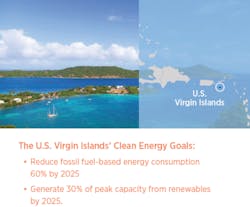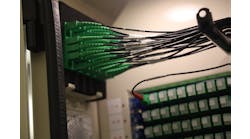How best to go about rebuilding is the multi-billion dollar question hanging over the US Virgin Islands as it picks itself up from massive destruction wrought by the recent hurricanes.
Hurricanes Irma and Maria took a heavy toll on the islands’ electric grids. Irma left St. Thomas and St. John without electricity when it made landfall early morning September 20. Two weeks later, Maria devastated St. Croix before moving on and doing the same in Puerto Rico.
Now a strong contingent of government and private sector leaders see microgrid opportunities arising out of the devastation — a chance to harness renewable energy resources in concert with the latest in distributed energy technologies to create a more robust and resilient grid.
Rebuilding energy infrastructure post Irma and Maria
The Virgin Islands estimates $5.5 billion is needed to repair and rebuild its infrastructure in the wake of the two successive Category 5 hurricanes, a historically unprecedented occurrence. That includes reconstructing the electric grid as well as schools, hospitals and government facilities. The figure also includes replacing revenue shortfalls.
The total is likely to increase as the extent of the damages and recovery costs become clearer, according to an estimate Virgin Islands’ Governor Kenneth Mapp submitted to U.S. congressional leaders on October 12.
Both the Virgin Islands and Puerto Rico rate poorly in terms of operational performance and fiscal health, but the Virgin Islands’ Water and Power Authority (WAPA) was arguably in somewhat better shape than the Puerto Rico Electric Power Authority (PREPA), which went bankrupt in July before the hurricanes struck. In any case, both island territories saw the collapse of utility electricity and electricity grid-dependent water services by the time Irma and Maria moved on.
According to an Oct. 1 Infrastructure Security and Energy Restoration update from the U.S. Department of Energy (DOE), WAPA had restored grid services to approximately 15 percent of customers on St. Thomas and 10 percent of those on St. Croix. That included critical facilities, such as airports and hospitals, compared to only five percent of PREPA customers at the time in Puerto Rico.
By November 20 — two months after the storms — massive outages remained. Power was restored to just over one third of Virgin Island electric customers. Still without power were 52.8 percent of customers on St. Thomas, 76.1 percent on St. Croix, and 60 percent on St. John, according to the DOE.
A hybrid microgrid on St. Croix
An island microgrid already in operation offered perspective on how such systems fare in extreme weather. Working with project partners, Texas-based Ideal Power deployed an off-grid solar-plus-storage microgrid that provides electrical power to a commercial facility on St. Croix. Like many such facilities in the Virgin Islands and across the Caribbean, the commercial facility has never been connected to the utility grid, instead relying on diesel power generation 24 hours a day, seven days a week, Ideal’s John Merritt told Microgrid Knowledge.
Learn more about microgrid opportunities in storm rebuilding. Attend Microgrid 2018.
Ideal’s six Stabiliti 30C3 multi-port power conversion systems integrate solar photovoltaic (PV) and lithium ion battery energy storage with the facility’s preexisting diesel generators.
“Hurricane Maria’s high winds damaged the commercial facility’s rooftop solar panels. However, the batteries, control systems, generators and Ideal Power’s converters are in good shape,” said Merritt, Ideal Power’s director of applications engineering. “We are working with our partners to repurpose on-site assets, although the solar PV array is idle at the moment.”
The site will continue to offset fuel use by pairing the batteries with diesel generation, he continued. “Batteries without solar can still reduce fuel use and generator run-times. With clever load management, we should be able to run the facility on batteries alone.”
In the morning, control systems automatically start the generators and charge the batteries, enabling them to support late afternoon and nighttime loads, Merritt said.
Microgrid opportunities on the Virgin Islands
Ideal has received “quite a few inquiries from companies wanting us to assist with island recovery efforts,” he added. “We’re looking forward to more opportunities to serve businesses with robust and timely modular microgrid solutions,which in addition to reducing power consumption and electricity costs are better for the environment.”
*USVI Energy Transition Initiative, NREL
The Rocky Mountain Institute (RMI) manages a 144-MW portfolio of renewable energy and energy efficiency projects across the Caribbean region.
“It’s not that difficult to get up to those numbers. We’re working in partnership with 13 islands at present to develop large-scale solar, wind and geothermal energy resources, and of course battery storage,” said Christopher Burgess, RMI Islands energy program director.
RMI has completed two national energy transition strategies – one on St. Lucia and one for St. Vincent and the Grenadines. These lay out a path for the island nations to transition from reliance on diesel power generation to decentralized renewable energy systems that make use of mixes of locally available and appropriate resources.
“Just adding intelligent battery energy storage reduces the cost and raises the efficiency of power generation. Adding renewables makes even more sense,” Burgess said.
Realizing Caribbean microgrid and renewable energy resource potential
St. Lucia has 70 MW of renewables up and running, and project partners are looking at installing a battery-based energy storage system with 10 MWh of energy capacity. On St. Vincent, where peak loads average around 25 MW, project partners are considering deploying a 5 MWh battery storage solution to augment spinning reserve capacity, Burgess said.
*RMI
Investing in decentralized renewables, energy storage systems and microgrids conveys multiple benefits: They reduce the cost of producing and distributing electricity and enhance grid reliability. They add resiliency and reduce or even eliminate the long-term costs to human and environmental health and quality of life associated with diesel fuel generation. Finally, they provide a boost to local employment and economies, according to Burgess and RMI.
RMI’s strategic approach to Caribbean energy transition is founded on three pillars.
The first entails carrying out unbiased, across the board energy resource, grid capacity and distributed energy resource assessments. The second entails identifying, developing and implementing the most promising projects, Burgess explained.
The third is capacity building, which entails building up information resources, fostering information and data sharing and exchange, and local education and training. Adding to that is RMI’s base of collaborating partners. There are now 600 organizations registered and making use of RMI’s Caribbean renewable energy and energy efficiency collaboration platform, which is run by CARILEC, an association of regional electric utilities..
“All these projects are unprecedented in the Caribbean region. It would probably drive a private developer mad, and broke, to see them through to fruition,” Burgess said “We’re a non-profit and we don’t take any sort of stake, or earn any returns, from these projects. By taking on these initial projects with our partners we can set a precedent. Then the commercial sector, government and utilities can take on new development projects and capacity building.”
A Caribbean-wide survey
*USVI Energy Transition Initiative, NREL
RMI is conducting a survey of the effects the hurricanes had on distributed energy systems across the Caribbean with an eye towards explaining why some withstood the storms’ onslaught better than others. The results will form the basis for a white paper RMI intends to publish.
“We have bona fide loads being served by a mix of solar PV and battery-based energy storage, either operating off-grid or in conjunction with utility grids, typically at hospitals, port facilities, water pumping stations and desalination plants, airports, community services facilities,” he said.
He added that Puerto Ricans, by and large, were prepared for hurricanes; they simply ran out of fuel after the first couple of days.
“The main point of our research is to uncover the differences in Caribbean distributed energy systems’ ability to withstand the hurricane-force winds and rain brought by Irma and Maria.
As is true throughout the Caribbean, the Virgin Islands can benefit by investing in renewable and hybrid microgrids and distributed energy storage systems, Burgess said.
[clickToTweet tweet=”#Microgrid opportunities arise out of the Virgin Islands post-hurricane rebuild” quote=”#Microgrid opportunities arise out of the Virgin Islands post-hurricane rebuild”]
Virgin Islands residents, industrial plant operators and commercial businesses, such as those served by Ideal’s hybrid, solar-diesel-storage system on St. Croix, have installed solar PV, and in some cases, intelligent battery energy storage systems.
One issue to be resolved is their compliance with the safety requirements set out in IEEE1547, a set of criteria and requirements for the interconnection of distributed generation resources into the power grid. Complying with the standard means distributed generation automatically shuts down in the event of a grid outage. That was the case on St. Thomas and St. John, thereby eliminating the possibility of self-generation when the grid went down during the hurricanes, Burgess said.
“We can design a system that relies 100 percent on solar PV generation and intelligent, battery-based energy storage and lasts practically indefinitely. Had these types microgrids been installed, tragedies could have been avoided,” he added.
Track news about microgrid opportunities in the Virgin Islands. Subscribe to the free Microgrid Knowledge newsletter.







